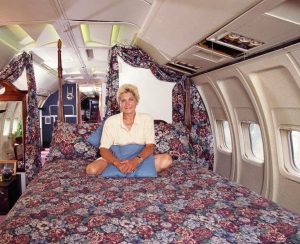Jo Ann Ussery’s story is a remarkable example of creativity, resilience, and determination in the face of adversity. While the use of unconventional materials such as shipping containers, buses, and tiny houses for residential construction has gained significant traction in recent years, Ussery was ahead of her time. She pioneered an extraordinary approach to alternative living long before it became a trend, proving that innovation and vision can transform even the most unexpected structures into functional, comfortable homes. Her incredible journey of converting a retired Boeing 727 into a fully livable residence in the 1990s remains a source of inspiration for those seeking affordable and unique housing solutions.

Ussery’s unconventional journey into aircraft living began in 1993 after a tragic loss. She had been living in Benoit, Mississippi, with her husband and two children when an unfortunate disaster struck—her home was completely destroyed. Left without a place to live and grappling with the emotional weight of her husband’s sudden passing, Ussery faced immense challenges. With limited financial resources, she initially considered purchasing a trailer as an affordable housing solution. However, after exploring her options, she quickly realized that the space offered by a typical trailer would not be sufficient to accommodate her growing family.
At that crucial moment, her brother-in-law Bob, an air traffic controller, suggested an unusual idea—why not live in an airplane? The idea was unconventional, but it immediately intrigued Ussery. Determined to explore the possibility, she visited an old Boeing 727 that had been retired from service. As soon as she set foot inside, she felt an instant connection to the aircraft. Unlike traditional homes, this plane offered a sturdy structure, a unique shape, and a vast amount of interior space. Even more surprising was the cost. The aircraft itself was available for just $2,000, which even included transportation to her property. Motivated by the knowledge that real estate mogul Donald Trump owned a private Boeing 727, Ussery decided to humorously nickname her own plane “Little Trump.”
What followed was an ambitious and labor-intensive project that required careful planning, substantial effort, and a modest investment of around $30,000—equivalent to approximately $60,000 today. Rather than viewing the plane as merely an old aircraft, Ussery saw its potential as a blank canvas for a one-of-a-kind living space. Her first challenge was to position the plane securely on her property. She carefully placed it with the nose facing a scenic lake, ensuring that it had a stable foundation. The tail section was anchored with concrete to prevent any movement, providing structural integrity during the renovation process.
Once the aircraft was in place, Ussery embarked on the extensive transformation. The Boeing 727 offered an impressive 1,500 square feet of interior space—far more than a conventional trailer could provide. With 76 windows lining its fuselage, natural light flooded the space, adding to the feeling of openness. However, significant modifications were needed to make the aircraft suitable for full-time living. While the plane’s original windows were not functional, Ussery installed an efficient air conditioning system to maintain a comfortable indoor climate. Insulation was also a priority, ensuring that the space remained livable in various weather conditions.
The interior underwent a complete overhaul. Ussery stripped away unnecessary elements, installed new flooring, and repurposed key features of the aircraft to maximize efficiency. The overhead compartments, once used for storing passengers’ luggage, were cleverly adapted into additional storage space. The aircraft’s existing bathroom was remodeled to serve a more practical residential function. Every detail was carefully considered to ensure that the layout was both functional and inviting.
Upon completion, the result was nothing short of extraordinary. The transformed aircraft became a fully equipped home featuring three cozy bedrooms, a welcoming living area, a fully functional kitchen, and a convenient laundry room. Unlike many alternative housing solutions that sacrifice comfort for novelty, Ussery’s Boeing 727 provided a level of livability comparable to traditional homes. She went beyond basic necessities by incorporating modern conveniences such as an oven and a phone, making daily life more practical.
One of the most stunning aspects of the renovation was her transformation of the cockpit. Instead of leaving it unused, she ingeniously converted it into a luxurious master bathroom. The highlight of this unique space was a soaking tub positioned to take full advantage of the breathtaking view of the lake outside. Entering the cockpit-turned-bathroom created the illusion of being suspended in mid-air, adding an element of whimsy and grandeur to the home’s design. It was a perfect blend of functionality and artistry.
What made Ussery’s accomplishment even more remarkable was the fact that she undertook this enormous project largely on her own. From 1995 to 1999, she and her children lived comfortably in their unconventional yet fully functional home. The experience proved to be deeply rewarding, demonstrating that with enough creativity and determination, it is possible to turn even the most unusual spaces into a welcoming and habitable environment.
Inspired by the uniqueness of her home, Ussery eventually decided to share her remarkable creation with the public. She envisioned turning the aircraft into a museum, allowing visitors to experience firsthand the possibilities of adaptive reuse. Unfortunately, tragedy struck once again. While attempting to move the airplane a short distance, a devastating accident occurred. The aircraft slipped off its transport and was irreparably damaged, bringing an abrupt end to Ussery’s extraordinary project.
Although her Boeing 727 home no longer exists, its legacy endures. Ussery’s vision, ingenuity, and perseverance continue to inspire people interested in unconventional living spaces and sustainable housing alternatives. Her story is a testament to the power of thinking outside the box and embracing innovation in the pursuit of personal fulfillment and practical solutions.
Today, as more individuals explore alternative housing options such as container homes, converted school buses, and tiny houses, Ussery’s groundbreaking endeavor remains a shining example of what is possible when creativity and resilience come together. Her transformation of an obsolete aircraft into a warm and inviting home challenges conventional ideas of what a house should be and opens the door to limitless possibilities for future generations. Through her journey, she demonstrated that even in the face of adversity, with enough determination, one can turn a dream into reality.





